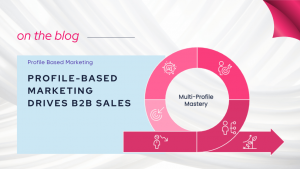LinkedIn is a great resource for sales and marketing professionals. Finding your target audience on LinkedIn is where most people start.
In this blog post, we’ll review the three most common mistakes I see people making when trying to generate leads on LinkedIn.
In today’s competitive sales and marketing world, standing out, being memorable, adding value and building trust is more important than ever. Before you start using LinkedIn’s directory, you will need to have the best possible LinkedIn profile.
Okay, let’s pinpoint and attract your target audience by avoiding three clear mistakes.
1. Poor use of LinkedIn search filters
Whether you are on LinkedIn.com free tool, or LinkedIn’s upgraded account, Sales Navigator; the search functionality is excellent. Sometimes they throw up false positives, but on the whole, both work well.
Poor use of some filters can reduce the number of companies or people that turn up in your search.
However, with a lack of accurate targeting your search can be also be too broad.
This means you will find yourself connecting to people irrelevant to you and your business, or missing those that could be perfect for you.
How to get accurate search results from LinkedIn:
Use the ‘industry’ and ‘company headcount’ filters when performing an ‘Account search’. ie. Find the companies first.
Afterwards, you find the people that work in those identified companies.
(Searching for the industry and company headcount against a LEAD search gives you inaccurate results.)
Note- Revenue is not an obligatory field for companies to fill in and update, whereas full-time employees (FTEs) is an obligatory field. To maximise the companies in your search use FTEs rather than revenue.
The keyword search box at the top is excellent on company pages, but use with caution for lead searches.
Those keywords will search for any word on the profile page.
For a company page a keyword search is useful as it helps you identify what the company does from the description or specialities list. It is an accurate way of searching.
On a personal profile, the keyword search could pick up on any word in the profile, such as words used on a previous job experience.
e.g. If you are looking for a MarTech company, search industry ‘marketing & advertising’ then in the keywords add words like Platform OR SaaS to find tech companies as opposed to agencies. However, if you are looking for marketing directors of SaaS companies, adding SaaS to the keyword could simply be in a sentence about a previous company.
Use a boolean search instead of the job title dropdown when searching for leads.
This often gives you more people in the pool due to the varied nature of job titles. The other way to do this is to search the keyword only (click enter without clicking on a dropdown) and then mix that with the Seniority filter.
Sometimes Seniority gives some false positives so my preference is a proper boolean.
A boolean in the Title filter might look like this;
(Chief OR Director) AND (Marketing OR Comms OR Communications OR Brand OR PR OR “Public Relations”)
2. Targeting people who are not active on LinkedIn
The most natural way to spark up a new conversation with people you’d love to work with, is via the posts and comments.
These are the topics they are being public about, and they would welcome your attention on that topic.
This means your prospective client will be more open talking to you about these things. Once you’ve built trust and credibility, you can extend the conversation.
If the people you’re focusing on are just your decision makers who aren’t very active on LinkedIn, you’ll find it hard to learn about the company priorities, and your conversations will be without context.
This leads to connection messages accepted without reply messages, your follow up, the dreaded ghosting, which leads to desperate sales pitch inbox messages. You don’t want to be that guy!
How to find people who are active on LinkedIn:
Do a lead search on sales navigator, and add one of the spotlight filters – ‘those that were active in the last 30 days’. If they have posted in the last 30 days, they are likely to be active in the next 30 days.
If you have Sales Navigator, go to the Lead Shares filter on your home page to find your saved leads posts.
If you don’t have Sales Navigator, click on a hashtag, or search for it via this url – https://www.linkedin.com/feed/hashtag/?keywords=funny
(just change the keyword at the end for your relevant hashtag);
Change the filter from ‘top’ to ‘recent’ and you’ll find people that have just posted under that hashtag.
Engage with their post, and connect, voila!
3. Random targeting of individuals in your target industry
For any business selling into enterprise companies, it is better to be connected with 30 people in 100 accounts, than one person in 3000 accounts.
I would recommend for any enterprise sales activity to go ‘Account First’ with your search and then connect and converse with a fairly high number of people in each account.
This helps you to;
- Target the accounts that you know you have relevant content and case studies for
- Learn about the company’s priorities before you connect and speak to a decision maker
- Comment on any colleagues post – this is very often seen by a lot of their colleagues inc. your decision maker
- Build relationships with people that can refer to you to right people
- Become ‘almost famous’ – cross-departmental brand awareness will help you close deals quicker
Strategy for this would be to connect in with the most active and those 2nd degree first.
Your decision maker becomes a 2nd degree connection once you are connected with their team. Once they see their colleagues as mutual connections it increases the chance of connection acceptance.
How to create a target list on LinkedIn:
Sales Navigator allows you to save a custom list of accounts.
You then find the most active and 2nd degree within those accounts.
Save these leads to Sales Nav (not just the accounts).
This means you then see their personal activity in your Sales Nav home feed, (Filter by Leads, and then Lead Shares to see posts only). Engaging with their latest post before connecting increases your connection acceptance rate.
LinkedIn.com search (free) is also quite sophisticated, you can search for people that are currently working in any company by job title.
Tip here is to connect in with the easier people (most active, more junior, 2nd degree) and then find others in the same company connected to them. You do this with the ‘Connections of’ filter.
Then you can re-target and work your way towards your decision makers of your target account.
LinkedIn is a great resource for sales teams
Most of us in sales could not imagine a world without our LinkedIn directory.
The people on the platform need to be treated with care, so they gain value from their interactions and they continue to use and peruse the platform for ours, and your services.
These tips will not only get you better searches, but also better conversations and relationships.
Remember, LinkedIn is usually only the start or part of the journey. Mix with email, calls to really build that trust, stay front of mind, and close more deals.
..
Learn More:
For further information, check out the Pitch 121 learn with us section by clicking here
If you have any questions, please reach out to a member of the Pitch 121 team. We would be super happy to hear from you.
Web: www.pitch121.com
Email: hello@pitch121.com





